High Point, North Carolina Blood Testing Facilities
 Represents a LabCorp blood testing facility
Represents a LabCorp blood testing facility Represents a Quest Diagnostics blood testing facility
Represents a Quest Diagnostics blood testing facility
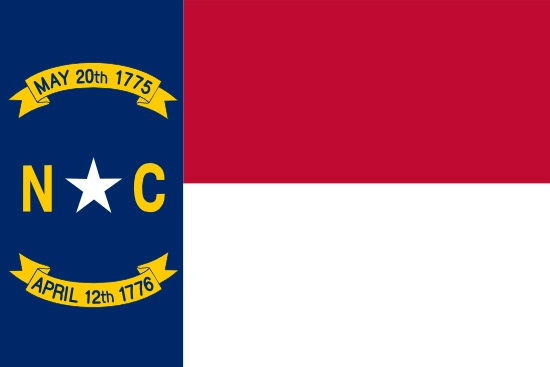
Nearby Labcorp Blood Testing facilities:
- Labcorp Center Distance: 5 m, 3610 Peters Court Suite 200, High Point, Guilford County, NC, 27265
- Labcorp Center Distance: 7 m, 137 Mt. Calvary Road Suite B, Thomasville, Davidson County, NC, 27360
- Labcorp Center Distance: 11 m, 445 Pineview Dr Ste 210, Kernersville, Forsyth County, NC, 27284
- Labcorp Center Distance: 15 m, 1126 N Church St Ste 104, Greensboro, Guilford County, NC, 27401
- Labcorp Center Distance: 18 m, 3333 Brookview Hills Ste 103, Winston Salem, Forsyth County, NC, 27103
- Labcorp Center Distance: 19 m, 610 N Fayetteville St. Ste 110, Asheboro, Randolph County, NC, 27203
- Labcorp Center Distance: 22 m, 7122 Village Medical Circle, Clemmons, Forsyth County, NC, 27012
- Labcorp Center Distance: 28 m, 1690 Westbrook Avenue, Burlington, Alamance County, NC, 27215
- Labcorp Center Distance: 29 m, 1041 Kirkpatrick Rd, Burlington, Alamance County, NC, 27215
- Labcorp Center Distance: 31 m, 855 Heather Rd, Burlington, Alamance County, NC, 27215
- Labcorp Center Distance: 32 m, 601 Mocksville Ave Ste B, Salisbury, Rowan County, NC, 28144
- Labcorp Center Distance: 33 m, 520 Maple Ave Ste A, Reidsville, Rockingham County, NC, 27320
- Labcorp Center Distance: 41 m, 3940 Arrowhead Blvd Ste 240, Mebane, Alamance County, NC, 27302
- Labcorp Center Distance: 47 m, 478 Copperfield Blvd, Concord, Cabarrus County, NC, 28025
- Labcorp Center Distance: 49 m, 18877 Jeb Stuart Highway, Stuart, Patrick County, VA, 24171
- Labcorp Center Distance: 50 m, 752 S Andy Griffith Pkwy, Mount Airy, Surry County, NC, 27030
- Labcorp Center Distance: 51 m, 942 Johnson Ridge Road Ste U, Elkin, Surry County, NC, 28621
- Labcorp Center Distance: 52 m, 100 Timberhill Place Suite 122, Chapel Hill, Orange County, NC, 27514
- Labcorp Center Distance: 54 m, 174 Executive Drive Ste C, Danville, Other, VA, 24541
- Labcorp Center Distance: 56 m, 1133 Carthage Street Unit De, Sanford, Lee County, NC, 27330
- Labcorp Center Distance: 59 m, 8 Regional Circle, Pinehurst, Moore County, NC, 28374
- Labcorp Center Distance: 60 m, 10030 Gilead Road Ste 100-B, Huntersville, Mecklenburg County, NC, 28078
- Labcorp Center Distance: 61 m, 8401 Medical Plaza Dr. Ste 140, Charlotte, Mecklenburg County, NC, 28262
- Labcorp Center Distance: 62 m, 4111 Ben Franklin Blvd, Durham, Durham County, NC, 27704
- Labcorp Center Distance: 64 m, 107 Weeks Drive, Roxboro, Person County, NC, 27573
- Labcorp Center Distance: 65 m, 3601 Davis Drive, Morrisville, Wake County, NC, 27560
- Labcorp Center Distance: 66 m, 1902 West Park Drive, North Wilkesboro, Wilkes County, NC, 28659
- Labcorp Center Distance: 68 m, 1718 East 4Th Street Ste 302, Charlotte, Mecklenburg County, NC, 28204
- Labcorp Center Distance: 69 m, 104 Bass Lake Road Suite 100, Holly Springs, Wake County, NC, 27540
- Labcorp Center Distance: 70 m, 530 New Waverly Pl Ste 306, Cary, Wake County, NC, 27511
- Labcorp Center Distance: 71 m, 1110 Se Cary Pkwy Ste 205, Cary, Wake County, NC, 27518
- Labcorp Center Distance: 73 m, 3200 Blue Ridge Road Ste 200, Raleigh, Wake County, NC, 27607
- Labcorp Center Distance: 74 m, 1949 Tate Blvd Se, Hickory, Catawba County, NC, 28602
- Labcorp Center Distance: 75 m, 8300 Health Park Suite 223, Raleigh, Wake County, NC, 27615
- Labcorp Center Distance: 76 m, 10512 Park Rd Ste 107, Charlotte, Mecklenburg County, NC, 28210
- Labcorp Center Distance: 77 m, 6729 Falls Of Neuse Rd Ste 102, Raleigh, Wake County, NC, 27615
- Labcorp Center Distance: 78 m, 11001 Durant Road Ste 106, Raleigh, Wake County, NC, 27614
- Labcorp Center Distance: 79 m, 640 Summit Crossing Pl Ste 206, Gastonia, Gaston County, NC, 28054
- Labcorp Center Distance: 81 m, 10831 Forest Pines Dr Ste 108, Raleigh, Wake County, NC, 27614
- Labcorp Center Distance: 86 m, 95 Springbrook Ave. Ste. 107, Clayton, Johnston County, NC, 27520
- Labcorp Center Distance: 87 m, 2149 Valleygate Dr Suite 101, Fayetteville, Cumberland County, NC, 28304
- Labcorp Center Distance: 88 m, 2460 India Hook Rd Ste 101, Rock Hill, York County, SC, 29732
- Labcorp Center Distance: 92 m, 400 East Burwell St, Salem, Other, VA, 24153
- Labcorp Center Distance: 93 m, 237 Longvue Drive Ste C, Boone, Watauga County, NC, 28607
- Labcorp Center Distance: 95 m, 5305 Valley Park Dr Ste 7, Roanoke, Roanoke County, VA, 24019
- Labcorp Center Distance: 97 m, 328 N Brightleaf Blvd, Smithfield, Johnston County, NC, 27577
Nearby Quest Blood Testing facilities:
- Quest Center Distance: 15 m, 1002 N Church St, Greensboro, Guilford County, NC, 27401-1448
- Quest Center Distance: 19 m, 200 Charlois Blvd, Winston Salem, Forsyth County, NC, 27103-1536
- Quest Center Distance: 32 m, 611 Mocksville Ave, Salisbury, Rowan County, NC, 28144-2738
- Quest Center Distance: 49 m, 509 Brookdale Dr, Statesville, Iredell County, NC, 28677-4107
- Quest Center Distance: 69 m, 103 Baines Court, Cary, Wake County, NC, 27511-6646
- Quest Center Distance: 70 m, 530 New Waverly Pl, Cary, Wake County, NC, 27518-7414
- Quest Center Distance: 73 m, 1014 Procure St., Fuquay Varina, Wake County, NC, 27526-2620
- Quest Center Distance: 74 m, 1781 Tate Blvd South East, Hickory, Catawba County, NC, 28602-4218
- Quest Center Distance: 76 m, 11111 Carmel Commons Blvd, Charlotte, Mecklenburg County, NC, 28226-4075
- Quest Center Distance: 80 m, 3031 New Bern Ave, Raleigh, Wake County, NC, 27610-2989
- Quest Center Distance: 86 m, 4655 Cleburne Blvd, Dublin, Pulaski County, VA, 24084-4412
- Quest Center Distance: 87 m, 202 8Th St, Radford, Other, VA, 24141-2426
- Quest Center Distance: 89 m, 2001 Crystal Spring Ave Sw, Roanoke, Other, VA, 24014-2465
- Quest Center Distance: 90 m, 1932 Braeburn Drive, Salem, Other, VA, 24153-7302
North Carolina Hormone Replacement Therapy Services
Human Growth Hormone Injections in North Carolina
Did you know that Hormone Imbalance is one of the strongest pressures which contribute to premature aging? As we grow older, HGH Levels start to decline, and we start to age more quickly as a direct result. Many men and women over the age of 30 suffer from Age-Related Growth Hormone Deficiency, a condition which exacerbates the aging process, severely damaging both health and well-being
The Conscious Evolution Institute offers Physician-Monitored HGH Injections for the treatment of Growth Hormone Decline. We can get you the help you need to restore your hormone balance and boost your health. We can help you buy the HGH you need and even ship it to your doorstep.
Sermorelin Acetate Therapy Services in North Carolina
We also offer Sermorelin Treatments as an alternative to HGH Shots. Both are highly effective at restoring natural and youthful hormone balance, but Sermorelin does so by helping your body make more HGH on its own, rather than supplementing the body's diminishing supply.
Many people prefer Sermorelin Acetate because it's cheaper than Human Growth Hormone Replacement Therapy, but others feel that the results of HGH Injections are more noticeable. One of our clinical physicians will help you make the best decision for your health and your wallet.
North Carolina Low-T Treatments
Along with HGH Restoration, we also provide Testosterone Replacement Therapy for the treatment of Erectile Dysfunction and Testosterone Deficiency. Many men turn to pills as a means to restore their sexual potency, but these pills may simply be masking underlying problems that are eating away at your health.
Testosterone is a vitally important hormone for male health, and ED Pills do nothing to restore hormone balance, they simply alter your blood flow to foster easier sexual activity. Men with Testosterone Deficiency are more prone to Age-Related Disorders such as diabetes and obesity, and they are at significantly increased risk of other metabolism disorders, as well as cardiovascular disease, heart attack and stroke.
Women can also benefit from Testosterone Replacement as a means to mitigate the effects of menopause, strengthen the bones, and restore sex drive.
The HCG Diet for North Carolina Residents
Are you overweight? Do you have chronic health issues that are exacerbated by obesity? The Conscious Evolution Institute can help you solve your weight problems with our highly effective HCG Diet. HCG is short for Human Chorionic Gonadotropin, and this natural biological hormone has been shown to be an effective weight loss aid.
HCG Injections, when combined with a restricted diet, encourage the body to burn pesky reserves of adipose fat, while also helping sustain energy levels, preventing the fatigue normally associated with accelerated weight loss. HCG has the special ability to mask feelings of hunger, helping you avoid the temptation of unhealthy foods, helping you lose weight quickly as well as responsibly.
Largest Metropolitan Areas of North Carolina
Charlotte
Charlotte is the biggest city and metro area in the state of North Carolina. Charlotte also goes by the nickname of The Queen City, as it was named after King George III wife, Queen Charlotte. Charlotte is highly valuable to the American economy primarily because of its vital importance as a banking center. The only city in the United States that houses financial institutions with a greater net worth is New York City. The city is also home to a number of Fortune 500 companies.
Charlotte also has a strong professional sports presence, bulwarked by the Charlotte Panthers and the Charlotte Bobcats. The city is also home to a number of colleges, including the University of Charlotte and UNC-Charlotte.
Raleigh
Raleigh, North Carolina is the second largest city in the state, as well as its capital. Raleigh also goes by the nickname of The City of Oaks, because of its multitude of Oak Trees which are planted all throughout the city. Like Charlotte, Raleigh has a strong financial presence, but it is most well-known for its medical and high-tech research.
The city of Raleigh is one of the cities on Tobacco Road, the region of North Carolina with the most competitive college basketball in the United States. Raleigh is the home of NC State University. Raleigh is also home to the NHL team, the Carolina Hurricanes.
Greensboro
Greensboro is the central city of the Piedmont Triad region of North Carolina, and is the third most populated city in the state. Greensboro has a surprisingly active arts community, with an emphasis on theater, contemporary, and classical music. The most prestigious sports competition held in the Greensboro area is the FedEx Cup.
There are a number of small colleges and universities in Greensboro, a couple of the most notable of which are the Elon Law School and UNC-Greensboro. Greensboro has been historically known for its strong textile industry, as well as being a center of tobacco processing and distribution.
Winston-Salem
Winston-Salem is the fourth largest metropolitan population in the state, and is another city in the Piedmont Triad area, along with Greensboro. Winston-Salem is probably most well-known as a center of the tobacco industry, and the home of R.J. Reynolds, the maker of Camel Cigarettes.
Like Greensboro, Winston-Salem also has an active arts and cultural community, with an emphasis on theater and fine arts. The most well-recognized university in the Winston-Salem area is Wake Forest University. The largest industries in Winston-Salem are Health Care, Fabrication, and Retail.
Durham
Durham is most famous for being the home of Duke University, and Chapel Hill is the home of the University of North Carolina. The two universities are only ten miles apart, and are the foundation of Tobacco Road, as well as representing the biggest basketball rivalry in the United States. Durham has a strong contemporary music scene, and has contributed a number of bands and artists to the national landscape, including The Mountain Goats and the Carolina Chocolate Drops.
Duke University and its hospitals are the biggest employers of Durham, but there is also a strong high-tech presence, the largest representatives of which are GlaxoSmithKline and IBM. Forbes' has listed Durham as one of the best cities in the United States to start a career.
All About High Point, North Carolina Geographic Area
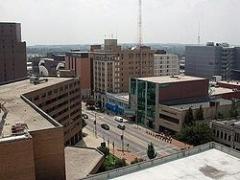

High Point is a city located in the Piedmont Triad region of the U.S. state of North Carolina. As of 2010 the city had a total population of 104,371, according to the US Census Bureau. High Point is currently the eighth-largest municipality in North Carolina.
High Point is known for its furniture, textiles, and bus manufacturing. The city is sometimes referred to as the "Furniture Capital of the World" although its official slogan is "North Carolina's International City" due to the semi-annual High Point Market that attracts 100,000 exhibitors and buyers from around the world. The area code is 336.
It is home to two universities: High Point University, a private Methodist-affiliated institution founded in 1924, as well as Laurel University, a private interdenominational Christian university.
Most of the city is located in Guilford County, with portions spilling into neighboring Randolph, Davidson, and Forsyth counties. High Point is North Carolina's only city that extends into four counties.
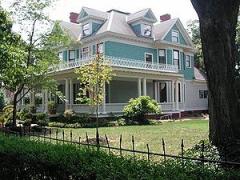
Among the first Europeans to settle Guilford County were Quakers and German immigrants. High Point was located at the highest point of the 1856 North Carolina Railroad between Charlotte and Goldsboro where it intersected the 1852 Great Western Plank Road. Its central location and transportation allowed for the delivery of raw materials like cotton and lumber and processed goods in and out of the city and contributed to its early growth. Settled before 1750, High Point was incorporated in 1859. Before it became a major manufacturing center, the most important industries were tobacco, woodworking and textiles. The first of many High Point furniture factories was opened in 1889.
Established in 1924, High Point University is a liberal arts institution with approximately 3,000 undergraduate and graduate students from 52 countries and 36 states at campuses in High Point and Winston-Salem. It is ranked by U.S. News and World Report 6th among comprehensive universities in the South and in the top 100 nationally. The university offers 45 undergraduate majors and five graduate-degree programs. It is accredited by the Commission of Colleges of the Southern Association of Colleges and Schools, and is a member of the NCAA, Division I and the Big South Conference.
High Point is the only city in North Carolina that exists within four counties: Davidson, Forsyth, Guilford, and Randolph. It also stands within two major watersheds: The Yadkin-Pee Dee and the Cape Fear. Parts of the city rise above 1,000 feet (300 m), making it among the highest cities in North Carolina's Piedmont.
High Point is located at 35 °58 a²14 a³N 79 °59 a²51 a³W / 35.97056 °N 79.9975 °W / 35.97056; -79.9975.
According to the United States Census Bureau, the city has a total area of 50.6 square miles (131.3 km ²), of which, 49.0 square miles (127.0 km ²) of it is land and 1.6 square miles (4.2 km ²) of it (3.24%) is water.
The climate in High Point is humid subtropical, with four seasons. Summers tend to be hot and humid, with the dewpoints rising to low and mid 70s during July and August. Fall and spring are mild. Winters are cold at night and mild during the day, but only a few days every winter does the temperature drop below -4 °C. Rainfall patterns are generally spread evenly throughout the year, with between seven and eleven wet days per month. Snowfall is unpredictable, with some winters experiencing little or no measureable snow and others characterized by occasional ice storms with small accumulations of snow and ice. January lows average -1 °C (30 °F) and highs average 10 °C (50 °F). July lows average 19 °C (67 °F) and highs average 32 °C (89 °F) although during heat waves, summer highs can cross 40 °C (104 °F). The lowest temperature ever officially recorded for the city was -22 °C (-7 °F), and the highest temperature ever recorded was 41 °C (106 °F). High Point has a humid subtropical climate, though being located between the mountains and the ocean it experiences less temperature fluctuation than other areas.
High Point was one of several communities impacted by a March 2010 Carolinas tornado outbreak. The twister reached its most powerful EF3 classification as it crossed the northern suburbs of the city.
In 1989, High Point sustained minor wind damage from Hurricane Hugo as it raced through the western Piedmont Plateau of North Carolina after making landfall 5 hours away in Charleston, South Carolina.
As of the census of 2000, there were 85,839 people, 33,519 households, and 22,523 families residing in the city. The population density was 1,750.1 people per square mile (675.7/km ²). There were 35,952 housing units at an average density of 733.0 per square mile (283.0/km ²). The racial makeup of the city was 54.56% White, 34.77% African American, 0.46% Native American, 4.45% Asian, 0.02% Pacific Islander, 2.27% from other races, and 1.57% from two or more races. Hispanic or Latino of any race were 6.89% of the population. 12.7% were of American, 8.7% English, 8.3% German and 5.9% Irish ancestry.
There were 33,519 households out of which 32.9% had children under the age of 18 living with them, 46.9% were married couples living together, 16.3% had a female householder with no husband present, and 32.8% were non-families. 27.2% of all households were made up of individuals and 9.5% had someone living alone who was 65 years of age or older. The average household size was 2.49 and the average family size was 3.03.
In the city the population was spread out with 26.0% under the age of 18, 9.3% from 18 to 24, 31.8% from 25 to 44, 21.0% from 45 to 64, and 11.9% who were 65 years of age or older. The median age was 34 years. For every 100 females there were 91.5 males. For every 100 females age 18 and over, there were 87.6 males.
The median income for a household in the city was $40,137, and the median income for a family was $48,057. Males had a median income of $33,411 versus $25,293 for females. The per capita income for the city was $21,303. About 10.5% of families and 13.2% of the population were below the poverty line, including 18.6% of those under age 18 and 11.4% of those age 65 or over.
Once synonymous with furniture, hosiery, and Hatteras yachts, High Point has diversified its economy as a center for distribution and logistics, customer service and banking, manufacturing, photography, and pharmaceuticals. The High Point Market remains a centerpiece to High Point's economy and the city's most recognized industry. The trade show is the largest furnishings industry trade show in the world. Approximately 12,000,000 square feet (1,100,000 m2) of showroom space is used by 2300 exhibitors, in 188 separate buildings.
The High Point Market has been noted for being a significant part of the region's larger furniture "cluster," which was discussed most recently by sociologist Richard Florida and initially by economist Michael Porter. The Market and its effects on the city have also been the focus of an extensive case study by urban sociologist John Joe Schlichtman. In this research, High Point's ability to capture the global furniture merchandising market is said to signal a new era in what is possible for small cities. Along these lines, Schlichtman terms High Point a "Niche City," which is "a city that forges global centrality by creating an economic specialization in a specific segment of the global service economy." In 2005, High Point adopted "North Carolina's International City" as its official slogan, emphasizing the role of international business and especially the High Point Market (formerly called the International Home Furnishings Market), the largest furnishings industry trade fair in the world.
Since 2005, the High Point Market has been receiving increasing competition from the huge World Market Center project in Las Vegas, Nevada, which, if fully built according to its multi-stage plan, is slated to exceed the High Point Market in square footage. In February 2011, speculation developed that Las Vegas World Market Center interests were positioning to purchase a controlling stake in the High Point Market. If this speculation is correct, World Market Center interests would control 64% of the square footage in downtown High Point.
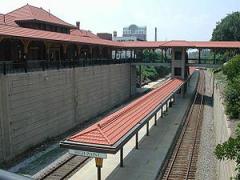
High Point is served by Piedmont Triad International Airport, which also serves Greensboro and Winston-Salem.
Amtrak's Crescent and Carolinian and Piedmont trains connect High Point (Amtrak station) with the cities of New York, Philadelphia, Baltimore, Washington, Richmond, Raleigh, Charlotte, Atlanta, Birmingham and New Orleans. The recently refurbished historic Amtrak station is situated at 100 West High Street.
Interstate 85 runs through southern High Point, southeast of the original interstate roadway, which is now designated Business 85. In the future, the new Interstate 74 will run north and east of the city. This section is referred locally as the "East Belt" freeway project, with construction scheduled to be completed after 2011. Part of this freeway is already built, and is signed U.S. Highway 311.
The Piedmont Authority for Regional Transportation (PART) also operates in High Point. It is a service that shuttles people in between most of the cities in the northwestern Piedmont region of North Carolina. High Point also provides public transportation. The main service for public transportation in High Point is Hi tran, the local bus service.
Highways passing through High Point include:
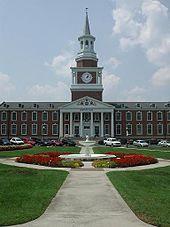
Private schools for the education of children were established in and around High Point as early as the early nineteenth century by Quakers. The New York Yearly Meeting of the Society of Friends, a network of Quakers from that state, started a school in Asheboro in the 1880s for African American students. The school relocated to High Point in 1891 on land east of town on Washington Street. The institution was named the High Point Normal and Industrial School (later William Penn High School), and was administered by the Quakers until 1897. In that year, black educator Alfred J. Griffin accepted the position of principal and led the establishment into a long period of growth.
The High Point public school system was founded in 1897 with the approval of a $10,000 bond, in part to finance the purchase of J. Elwood Cox aos family home on South Main Street for use as the first school building. Twelve school commissioners were appointed to administer the 350-student system of five grades. Growth of the city aos institutions reflected improved primary educational facilities. A school building campaign coupled with additional grades and improved classes resulted in four additional schools for white students: Elm Street School (1905), Park Street School (1910), Fairview School (1910), and Grimes Street School (1911). Many other schools were all born in the 1920s during a period of rapid growth.
This building spree culminated in 1927 with the opening of High Point High School. Among the many high styled school complexes in the state, few surpass High Point aos grand 1927 high school. The campus joined the talents of two designers; Greensboro architect Harry Barton and Charlotte landscape architect Earl S. Draper. The building was matched in 1931 with the addition of Ferndale Middle School just to the east, designed to incorporate details from the high school so that it maintained a campus theme. Both shared athletic facilities on a large tract of land between downtown and Emerywood. In 1962, High Point High School's name was modified to High Point Central High School when an additional high school, T. Wingate Andrews High School, was established in the 1960s.
Several private and independent schools are found in High Point, including High Point Christian Academy (Baptist), High Point Friends School (Quaker), Immaculate Heart of Mary (Catholic), Wesleyan Christian Academy, and Westchester Country Day School (nonsectarian), and Phoenix Academy, a charter school.
In 1921, the Chamber of Commerce made the establishment of a college in High Point a high priority and initiated a High Point College campaign. The campaign solicited funds in order to attract the attention of the North Carolina Methodist Protestants, who had desired for decades to found a college.
High Point succeeded in attracting the college over rivals Greensboro and Burlington with a gift of 60 acres (24 ha) and $100,000 in pledges from leading citizens. High Point College opened in 1924 (changed to High Point University in 1991) with three buildings at various stages of development. Many of the numerous civic organizations founded in the 1920s pledged funds, including the Rotary, Kiwanis, Civitan, and the American Business Club. The architectural design of the High Point College campus was in keeping with traditional and historical architectural initiatives found at many private colleges and universities across the state in the 1920s. The administration building (Roberts Hall), male and female dormitories (McCulloch Hall and Women aos Hall, respectively), and a central heating plant were all erected between 1922 and 1924 according to designs by Washington, D.C. architect R. E. Mitchell with assistance by High Point architect Herbert Hunter. Today, High Point University is a four-year, coeducational, liberal arts university related to the United Methodist Church. It offers 50 majors in a traditional day format. It also offers non-traditional evening programs, and the graduate studies program offers four master's degrees and six programs.
High Point is also the home of Laurel University, as well as one of the nine Shaw University "CAPE" (College of Adult and Professional Education) program centers.
Guilford Technical Community College also maintains a High Point campus.
The High Point Enterprise, established in 1885, is the only daily newspaper published in High Point. HP Magazine is a full color glossy lifestyle magazine that offers stories on food, history, events, the furniture industry, and more. The monthly magazine is the city's largest locally owned publication. Greensboro's News and Record also is available in High Point. Yes! Weekly and the Rhinoceros Times are free weekly papers covering High Point.
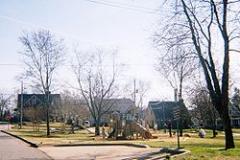
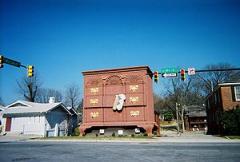
High Point makes up part of the Greensboro/Winston-Salem/High Point television designated market area. These stations are listed by call letters, channel number, network and city of license.
Word Count: 3262





